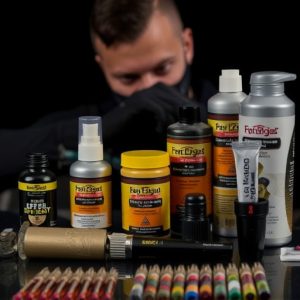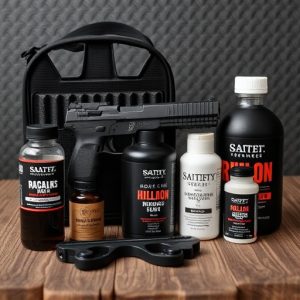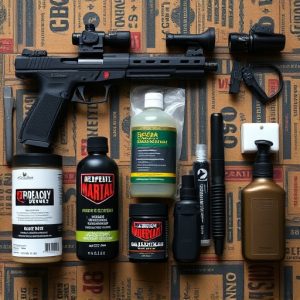Navigating the World of Personal Defense Products: Role, Evolution, and Ethical Considerations
Personal defense products have become a critical component of modern self-protection strategies, of…….
Personal defense products have become a critical component of modern self-protection strategies, offering a range of non-lethal options to deter potential threats and enhance personal safety. These tools—including pepper spray, stun guns, personal alarms, and training equipment—serve as effective deterrents by incapacitating assailants and acting as psychological barriers that can prevent violence. The evolution of these products from simple tools like slingshots to sophisticated items like pepper gel and laser dazzlers reflects a commitment to safety and innovation. Key factors in selecting the right personal defense product include matching it to your skill level, understanding legal restrictions, and considering the context of your environment. Ethical use is paramount, as these products can have significant psychological effects on users and targets. It's essential to choose a product that aligns with your unique needs and to practice using it proficiently. The responsible use of personal defense products, coupled with comprehensive safety education, is integral to a holistic approach to self-defense. Users must balance efficacy with ethical considerations to ensure their safety while respecting the well-being of others.
In an era where safety concerns are at the forefront of many individuals’ minds, the landscape of personal protection has evolved significantly. This article delves into the realm of less lethal weapons, more commonly known as personal defense products (PDPs), exploring their roles, evolution, and effectiveness in modern self-defense strategies. We will navigate the variety of options available, assess the ethical considerations they present, and guide readers on selecting a PDP that aligns with their specific needs. Join us as we unravel the complexities surrounding these tools designed to deter threats without resorting to lethal force.
Understanding the Role of Personal Defense Products in Modern Self-Protection
In an era where safety concerns are paramount, personal defense products have become integral to modern self-protection strategies. These products, ranging from pepper spray and stun guns to personal alarms and defensive training equipment, serve as a deterrent against potential threats. They are designed to provide individuals with the means to protect themselves in situations where physical confrontation cannot be avoided. The effectiveness of these tools lies not only in their ability to incapacitate an assailant but also in their role as a psychological barrier, often de-escalating potentially violent encounters through mere presence or display. For instance, a sturdy personal alarm can draw attention and deter would-be attackers, while pepper spray offers a non-lethal option for neutralizing a threat at a safe distance. The selection of personal defense products is tailored to suit various needs, ensuring that individuals can find the most appropriate tools based on their personal circumstances, skill level, and legal frameworks governing self-defense in their jurisdiction.
The evolution of personal defense products reflects a deeper understanding of the importance of empowering individuals with non-lethal options for self-protection. Manufacturers continue to innovate, incorporating advanced technologies and user-friendly designs to enhance effectiveness and accessibility. Training devices, for example, allow users to practice defensive techniques safely and effectively, fostering confidence and preparedness in potentially dangerous situations. Additionally, the integration of personal defense products into broader self-defense education initiatives underscores their role as part of a comprehensive approach to personal safety. By promoting awareness, skill development, and the responsible use of these products, society can collectively work towards mitigating the risks associated with personal safety threats, ensuring that individuals have the means to protect themselves should the need arise.
The Evolution and Variety of Less Lethal Weapons for Personal Defense
Less leaper weapons have undergone significant evolution over the years, reflecting advancements in technology and a growing need for effective personal defense products. The early history of less lethal weapons dates back to ancient times when simple objects like slingshots or stones were used for self-defense. Over time, the development of pepper spray in the 1960s marked a pivotal point in this evolution, providing law enforcement and civilians with a non-fatal means to incapacitate an assailant. Since then, the array of personal defense products has expanded exponentially. Today, the market offers a variety of options, ranging from stun guns and Tasers to impact munitions like batons and bean bag shotguns. The latter are designed to deliver controlled force, minimizing injury while effectively deterring aggression.
The recent advancements in personal defense products have led to the emergence of innovative devices such as personal alarm systems, pepper gel, and laser dazzlers. These items are engineered not only to incapacitate but also to ensure a high level of safety for the user and bystanders. The selection of personal defense products is tailored to suit diverse needs, from non-lethal weapons for law enforcement to individual self-defense tools for civilians. The continuous innovation in this sector underscores the commitment to enhancing personal security without resorting to lethal force. As a result, these less lethal weapons have become an integral part of modern personal defense strategies.
Evaluating the Effectiveness and Ethical Implications of Personal Defense Products
Personal defense products have become a focal point in discussions about safety and self-defense in various contexts, ranging from individual security to law enforcement applications. When evaluating the effectiveness of such products, it’s crucial to consider their design, performance under stress, and the training required for their safe and effective use. These products, which include pepper sprays, stun guns, and personal alarms, are often designed with the intent to incapacitate an assailant without causing permanent harm. Their effectiveness is typically measured by their reliability in deterring threats, ease of operation in high-pressure situations, and the speed at which they can be deployed.
The ethical implications of personal defense products extend beyond their immediate effectiveness in self-defense scenarios. These considerations encompass the potential for misuse, the psychological impact on both the user and the target, and the broader societal ramifications. Ethical concerns arise when considering how these products might influence interactions and alter behaviors, potentially escalating conflicts or leading to overreliance on personal defense tools. Moreover, the accessibility of such products to various demographics raises questions about equity and safety for all individuals within society. It is imperative that both the users and the creators of personal defense products approach their use with a keen understanding of their potential impacts, ensuring that their employment aligns with ethical principles and contributes positively to personal and public safety.
Selecting the Right Personal Defense Product for Your Needs: A Comprehensive Guide
When considering personal defense products, it’s crucial to evaluate your individual needs and circumstances. Factors such as legal restrictions, personal skill level, and the specific environments in which you intend to use these products play a significant role in determining the most suitable option. For instance, pepper spray or a stun gun might be ideal for someone living in an urban area, offering a non-lethal means of self-defense that can deter an attacker while minimizing potential harm. On the other hand, if you’re looking for a more versatile tool, a personal alarm could serve as an effective deterrent by drawing attention to your situation and deterring would-be assailants with its loud sound.
In addition to understanding the legal implications and your comfort level with the product, it’s essential to consider the effectiveness of each personal defense product in various scenarios. Pepper sprays, for example, are highly effective against most attackers but may be less useful against an aggressor wearing protective gear. Stun guns require proximity to be effective and should only be used as directed in training materials provided by manufacturers. Personal defense products like batons or kubotan keychain tools offer alternatives that can incapacitate an attacker through physical force rather than chemical agents. Regardless of the product you choose, consistent practice and familiarity with its operation are paramount to ensure it serves its intended purpose when needed most. Always prioritize legal compliance, safety, and personal proficiency with the chosen personal defense product to effectively safeguard yourself in potentially threatening situations.


